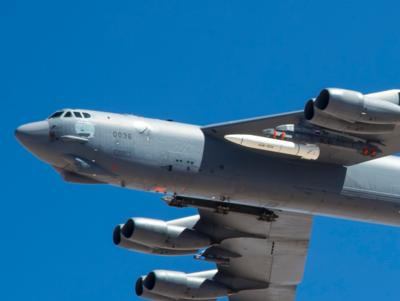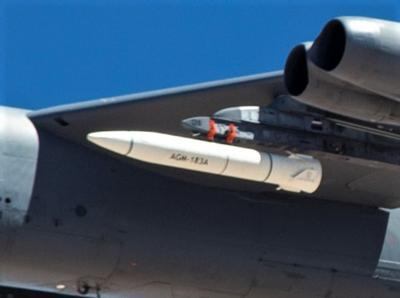Look Upon My Works, Ye Mighty …
The United States Air Force has successfully tested a prototype hypersonic missile. Dubbed the AGM-183A Air-launched Rapid Response Weapon, or ARRW (“Arrow”) the missile stands to be the Pentagon’s first hypersonic weapon to reach operational status.

The Lockheed-Martin-designed ARRW’s exact speed remains a closely-guarded secret. The missile, however, is reportedly based on Defense Advanced Research Projects Agency (DARPA) test platforms allegedly capable of reaching maximum speeds of Mach 20—a searing 13,335-knots.
Of the successful test conducted off the coast of California on 09 December 2022, the USAF stated: "This test was the first launch of a full prototype operational missile. Following the ARRW's separation from the aircraft, it reached hypersonic speeds greater than five-times the speed of sound, completed its flight path, and detonated in the terminal area. Indications show that all objectives were met."
In a separate statement, USAF Armament Directorate Program Executive Officer Brigadier General Jason Bartolomei remarked: "The ARRW team successfully designed and tested an air-launched hypersonic missile in five-years. I am immensely proud of the tenacity and dedication this team has shown to provide a vital capability to our warfighter."
The AGM-183A is what is known as a boost-glide vehicle. The term denotes warheads or projectiles that glide toward their targets after being propelled aloft by a rocket booster. Atmospherically, the ARRW is carried beneath the wing of an aircraft—such as the B-52H utilized in the offshore test flight. Once released from its underwing-pylon, the missile is borne spaceward by a solid rocket booster. Upon reaching a predetermined altitude and airspeed, the weapon’s payload fairings open, releasing the wedge-shaped, namesake, boost-glide vehicle contained within the missile’s fuselage.
Counterintuitively, boost-glide vehicles do not fall along the predictable, radiused trajectories characteristic of ballistic missiles; rather, they glide earthward, unpowered, approaching their targets along flatter trajectories. What’s more, boost-glide vehicles are capable of executing abrupt in-flight maneuvers.

Maneuverability in conjunction with extreme speed render weapons like the ARRW exceedingly difficult to detect, track, and defeat with contemporary air defense systems. Ergo, the U.S. Department of Defense (DoD) is about the business of developing a new class of interceptors by which the Pentagon seeks to counter the growing threat of near-peer nations developing hypersonic weapons.
According to the U.S. Air Force, the AGM-183A missile is designed to "hold fixed, high-value, time-sensitive targets at risk in contested environments;” which is to say the weapon will be used to target pre-determined assets on the ground, such as fixed missile sites, radar stations, air defense installations, infrastructure facilities, or even adversary headquarters buildings—in essence, any non-mobile enemy battlefield implement in need of swift and highly-prejudicial dispatch.
Flight testing of the AGM-183A has been underway since April 2021. Regrettably, a series of mishaps in which the missile's booster failed to fire raised doubts about the program’s viability. In July 2022, undisclosed Air Force sources said of the project: "You obviously wouldn't buy something that doesn't work.”
In light of the AGM-183A’s recent successful test flight, the USAF may well reevaluate its plans to forgo purchasing the weapon system.
 ANN's Daily Aero-Term (04.30.24): Runway Centerline Lighting
ANN's Daily Aero-Term (04.30.24): Runway Centerline Lighting ANN's Daily Aero-Linx (04.30.24)
ANN's Daily Aero-Linx (04.30.24) Airborne 04.24.24: INTEGRAL E, Elixir USA, M700 RVSM
Airborne 04.24.24: INTEGRAL E, Elixir USA, M700 RVSM Airborne 04.29.24: EAA B-25 Rides, Textron 2024, G700 Deliveries
Airborne 04.29.24: EAA B-25 Rides, Textron 2024, G700 Deliveries Airborne-NextGen 04.23.24: UAVOS UVH 170, magni650 Engine, World eVTOL Directory
Airborne-NextGen 04.23.24: UAVOS UVH 170, magni650 Engine, World eVTOL Directory




